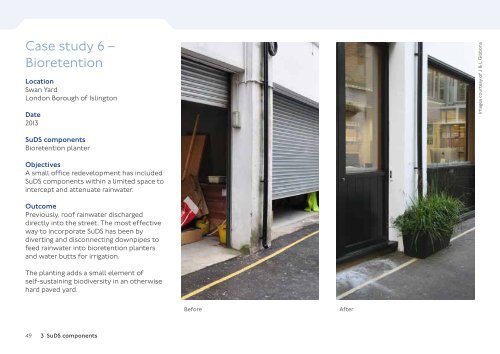SuDS in London - a guide
sustainable-urban-drainage-november-2016
sustainable-urban-drainage-november-2016
Create successful ePaper yourself
Turn your PDF publications into a flip-book with our unique Google optimized e-Paper software.
Case study 6 –<br />
Bioretention<br />
Location<br />
Swan Yard<br />
<strong>London</strong> Borough of Isl<strong>in</strong>gton<br />
Date<br />
2013<br />
Images courtesy of J & L Gibbons<br />
<strong>SuDS</strong> components<br />
Bioretention planter<br />
Objectives<br />
A small office redevelopment has <strong>in</strong>cluded<br />
<strong>SuDS</strong> components with<strong>in</strong> a limited space to<br />
<strong>in</strong>tercept and attenuate ra<strong>in</strong>water.<br />
Outcome<br />
Previously, roof ra<strong>in</strong>water discharged<br />
directly <strong>in</strong>to the street. The most effective<br />
way to <strong>in</strong>corporate <strong>SuDS</strong> has been by<br />
divert<strong>in</strong>g and disconnect<strong>in</strong>g downpipes to<br />
feed ra<strong>in</strong>water <strong>in</strong>to bioretention planters<br />
and water butts for irrigation.<br />
The plant<strong>in</strong>g adds a small element of<br />
self-susta<strong>in</strong><strong>in</strong>g biodiversity <strong>in</strong> an otherwise<br />
hard paved yard.<br />
Before<br />
After<br />
49 3 <strong>SuDS</strong> components


